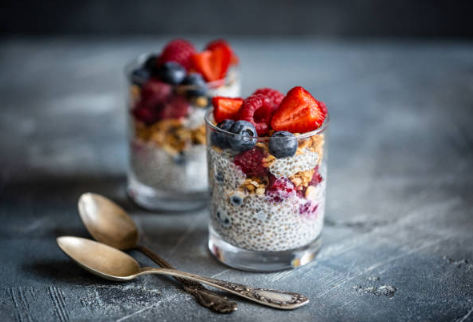Tiny but mighty, chia seeds have earned their place as a powerhouse ingredient in modern kitchens thanks to their impressive nutritional profile. Once famous for growing quirky “Chia Pets,” these little superfoods are now celebrated for their versatility in recipes—from creamy desserts to heart-healthy side dishes.
Though often used like whole grains, chia seeds are actually pseudograins, and they have a very mild flavor that absorbs whatever they’re paired with. When soaked, they form a gel-like texture, making them great for mixing into yogurt, smoothies, and salads.

What Are Chia Seeds?
Chia seeds are the edible seeds of Salvia hispanica, a desert plant native to Central America. They’re incredibly versatile and can be eaten raw, soaked, ground into flour, baked, or even used as a vegan thickener to replace eggs or dairy in recipes.
Their flavor is subtle and blends easily with other ingredients. However, their texture changes dramatically depending on how they’re prepared—whether raw, ground, or soaked into a gel.
Types of Chia Seeds
Chia seeds come in two main colors: black and white. While there’s little difference in taste or nutrition between them, black chia seeds tend to be slightly smaller. Both types can be used interchangeably in recipes. White seeds may contain extra chlorophyll when sprouted, but most commercial chia seed mixes include both varieties.
Health Benefits of Chia Seeds
Chia seeds offer more than just satisfying crunch and texture. They’re rich in alpha-linolenic acid (ALA), a plant-based omega-3 fatty acid, and a great source of micronutrients like potassium, magnesium, calcium, and iron. They’re also naturally gluten-free and cholesterol-free.
Additional benefits:
-
Anti-inflammatory support: Thanks to their omega-3s, chia seeds may help the body produce inflammation-fighting hormones.
-
Fiber-packed: Just one tablespoon of chia seeds provides about 5 grams of fiber, which is roughly the same as half an avocado.
-
Promotes satiety: Their fiber content can help you feel full longer, supporting weight management and gut health.

Nutrition Facts (Per 1 oz / ~2 tablespoons)
-
Calories: 138
-
Protein: 4.7g
-
Fat: 8.7g
-
Fiber: 10g
To get the most benefits, start with 1 tablespoon per day and gradually add more to your meals and recipes.
How to Use Chia Seeds
Chia seeds can be eaten raw or incorporated into recipes. Because of their quick liquid-absorbing outer shell, soaking them in milk or water for a few hours (or overnight) transforms them into a tapioca-like pudding texture.
Basic soaking ratio:
-
Mix ¼ cup chia seeds with 1 cup of liquid
-
Refrigerate for at least 2 hours
Not into soaking? No problem! You can also:
-
Blend them into smoothies
-
Bake them into cookies or muffins
-
Sprinkle them on oatmeal, grain bowls, or yogurt
Want a nutty aroma? Toast them in a 350°F (175°C) oven for 3–5 minutes until fragrant, then use them just like raw seeds.
Chia Seeds vs. Flaxseeds
While both are rich in fiber, omega-3s, and protein, there are key differences:
-
Chia seeds can be eaten whole and still be fully digested.
-
Flaxseeds need to be ground for the body to absorb their nutrients.
-
Flavor-wise, chia seeds are nearly flavorless, while flaxseeds have a mild nutty taste.
How to Buy Chia Seeds
You can find chia seeds in the health food section of most grocery stores or through online retailers. Good news: organic chia seeds are usually priced similarly to non-organic ones, so choosing organic is an easy way to avoid seeds treated with pesticides or chemicals.
How to Store Chia Seeds
Because chia seeds are high in polyunsaturated fatty acids (omega-3s), they can spoil in extreme conditions.
-
Store them in an airtight container
-
Keep them in a cool, dry place
-
Shelf life: 6 months to over a year, depending on storage
Check for off smells or changes in packaging—both signs that the seeds may have been exposed to air and could be going rancid.
Final Thoughts
Now that you know all about chia seeds, it’s time to start sprinkling them into breakfast muffins, chocolate desserts, or even mixing them into tuna salad. These tiny seeds pack a huge nutritional punch and add valuable versatility to both sweet and savory dishes.